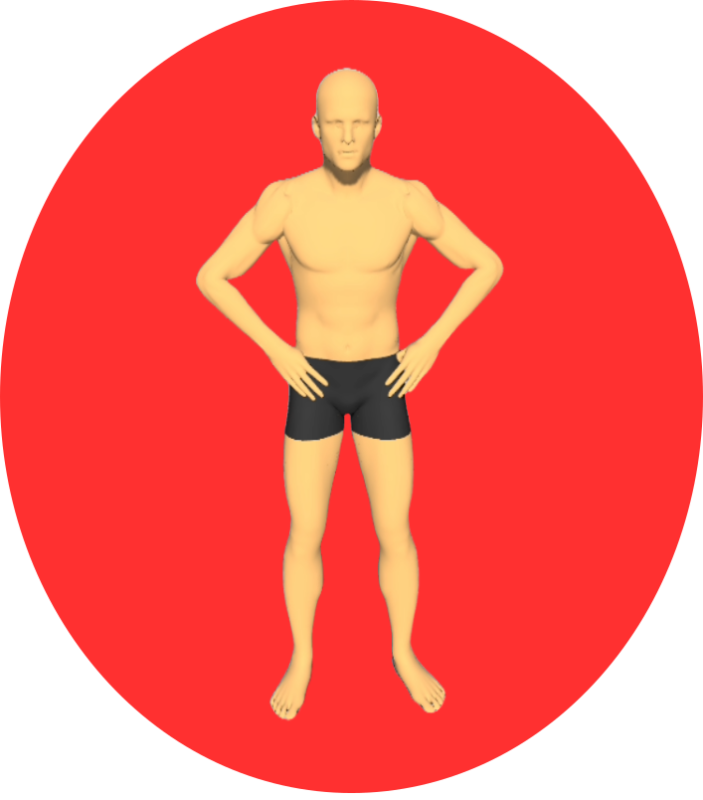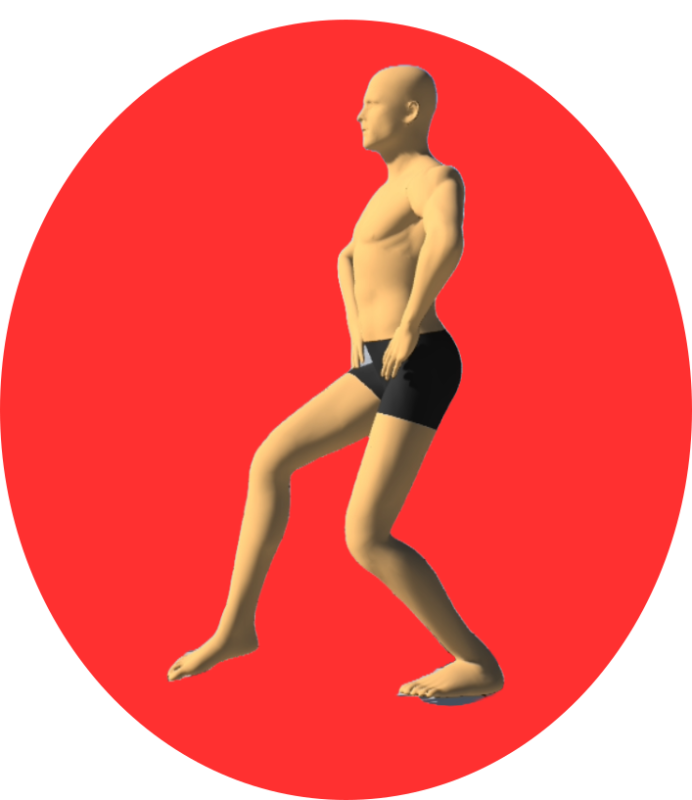立ち方は空手の基本中の基本
空手の立ち方は、空手における基本の中の基本です。型や組手などのあらゆる技術の土台となるもので、正しい立ち方を身につけることで、空手の技術を効率よく習得することができます。
立ち方 3つのポイント
空手の立ち方の重要性は、以下の3つの点にまとめることができます。
- バランスの安定
空手の技は、バランスを崩さずに正確に繰り出すことが重要です。正しい立ち方を身につけることで、重心が安定し、バランスを崩しにくくなります。
- 動きやすさ
空手の技は、素早く、かつ柔軟に繰り出すことが重要です。正しい立ち方を身につけることで、足腰が鍛えられ、動きやすくなります。
- 力強い打撃
空手の打撃は、力強く、かつ正確に繰り出すことが重要です。正しい立ち方を身につけることで、足腰が鍛えられ、打撃力がアップします。
具体的な立ち方の要点としては、以下のようなものが挙げられます。
- 足幅は肩幅程度で、つま先は正面に向ける。
- 膝は軽く曲げて、重心は両足の中央にかける。
- 背筋はまっすぐ伸ばし、肩は力を抜く。
- 視線は前方に向ける。
これらの要点を意識して、正しい立ち方を身につけるようにしましょう。
技術だけでなく精神性の体現も
また、空手の立ち方は、空手の精神性にもつながるものです。正しい立ち方を身につけることで、集中力や精神力が養われ、空手道の精神を体現することができます。
空手の立ち方は、空手道の基本であり、空手の技術を習得するために欠かせないものです。正しい立ち方を身につけて、空手の技術を効率よく習得し、空手道の精神を体現しましょう。
代表的な立ち方の解説
伝統空手も流派は多岐に渡り、基本姿勢においても、流派によって呼び方や形も多少の違いがあります。ここでは一般的な基本姿勢について説明していきます。

閉足立ち Heisoku-dachi
直立の姿勢で、両足の踵もつま先もつけたまま足を閉じた形で立ちます。
Stand in an upright position with your feet closed, heels and toes touching.
結び立ち Musubi-dachi
直立の姿勢で両足の踵はつけたままつま先を図のように開きます。ちょうど紐の結び目の様な形になることから、結び立ちと呼ばれています。
In karate, “musubi-dachi” is a basic standing stance. To assume musubi-dachi, stand up straight with your heels together. Then, open your toes so that they are about 30 degrees apart. This will create a stance that resembles a knotted string.


平行立ち Heiko-dachi
両足を肩幅程度に開いて両足の外側が平行になるように立ちます。つま先は少し内側を向く形になるはずです。
Stand with both feet shoulder-width apart, ensuring that the outer edges of both feet are parallel. Your toes should be slightly pointing inward.
八字立ち Hachiji-dachi
平行立ちの姿勢から、両足のつま先を外側に開き、前から見ると漢字の八の字になるように立ちます。
From the parallel stance, open your toes outward so that your feet form an “eight” shape from the front.


内八字立ち Uchihachiji-dachi
ナイファンチ立ちとも呼ばれることもあります。
八字立ちの逆で、平行立ちの姿勢から踵側を外に開いて逆八の字になるように立ちます。
This is the opposite of 8-character standing, from a parallel standing position, stand with your heels facing outward in a reverse figure-eight formation.
自然立ち Shizen-dachi
両足は肩幅程度に広げ、歩幅程度に左右の足を前後に広げます。下に目線を向けた時に前に出した足の親指が見えるか見えない程度に前足の膝を曲げて腰を軽く落とします。
Stand with both feet spread about shoulder-width apart and take a step’s distance between your left and right feet. Lower your body slightly by bending the knee of your front foot to a point where, when looking down, your front foot’s big toe is either slightly visible or not visible.


前屈立ち Zenkutsu-dachi
自然立ちの姿勢から、さらに前後の足幅を大きくした姿勢です。視線を下に向けた時、前に出した足の膝先が親指の付け根部分に重なる程度に膝を曲げ、後ろの足は膝を伸ばし、つま先は外側を向く形になります。横幅の感覚については、前足の踵を後ろにまっすぐ下げた時に、後ろ足の踵と触れ合うくらいの幅が理想です。丹田 を意識し、どっしりと重心を落とします。
This is a posture where you widen your stance even further from a natural standing position. When looking down, the front foot’s knee should be bent to the point where the tip of the knee overlaps with the base of the thumb, and the back foot should be straight with the toes pointing outward. In terms of width, the ideal distance is when the heel of the front foot is lowered straight back and touches the heel of the back foot. Be conscious of your lower abdomen and lower your center of gravity firmly.
猫足立ち Nekoashi-dachi
「結び立ち」の姿勢から、片方の足を前に出し、後ろ足に重心を乗せます。前に出した足は軽くつま先が地面に着く程度で踵は浮かせます。いつでも前に出した足で、蹴り技が繰り出せるようにバランスを保ちます。猫が前足で素早い攻撃を繰り出せる事からついた付けられた名前です。
From the “Musubi-dachi” position, move one foot forward and shift your weight onto the back foot. The forward foot lightly touches the ground with the toes while the heel remains raised, ensuring the balance is maintained for swift kicking maneuvers. The term “Neko” means cat, and “Ashi” means leg. It’s named so because of the similarity to a cat’s ability to swiftly attack using its front paws.


四股立ち Shiko-dachi
両足を大きく横に開き(肩幅の1.5倍程度)、背筋は伸ばしたまま、膝を曲げ腰をどっしりと落とします。両足のつま先は45度程度広がる形です。お相撲さんの「四股踏み」と同じ形です。やはり丹田を意識して、丹田を真下に重心を落とす感覚です。慣れない内は長く姿勢を保つのが辛いですが、鍛錬により安定した姿勢が築けてきます。
Stand with your feet spread widely apart, approximately 1.5 times the width of your shoulders. Keep your back straight while bending your knees and lowering your hips firmly. Both toes should be pointed at around a 45-degree angle. This stance is similar to the basic “shiko-fumi” posture in sumo wrestling. It’s crucial to maintain awareness of your lower abdomen and focus your center of gravity directly beneath it. Although it might be challenging to sustain this posture initially, consistent practice will lead to a more stable stance.
まとめ
これらの立ち方や呼び名については、先にも記した通り流派によって異なっていたりします。またここで紹介した立ち方以外にも、流派によってまだまだ多くの立ち方の種類や呼び名があります。しかしながら、どの立ち方にしても、型を繰り出す時にいつでも同じ形がつくれ、バランスよく安定した姿勢が保てる事が何より重要です。何度も何度も型の練習を繰り返すことで、安定した立ち方や姿勢を身に着けることができる様になるのです。




コメント